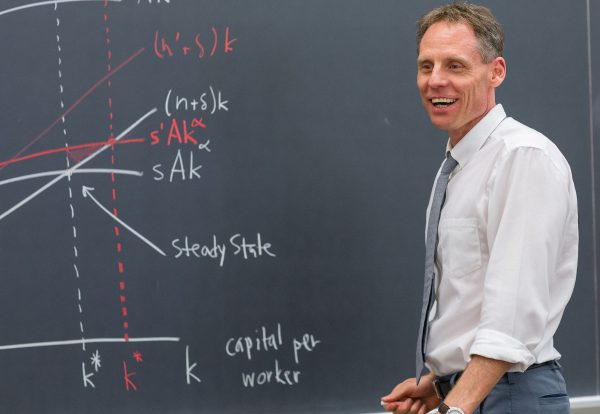

With much of the world debating how to reverse climate change during a sweltering summer, two Kalamazoo College faculty members are examining whether national attempts at combined trade and environmental policies might provide a key strategy.
The analysis by Patrik Hultberg, K’s Edward and Virginia Van Dalson Professor of Economics; and Darshana Udayanganie, a K assistant professor of economics, will be published soon in the Journal of Environmental Economics and Policy. Among their findings, it will note that Europe and the U.S. are talking about adopting border-adjustment taxes by 2026, targeted toward influencing foreign countries’ carbon emissions.
Hultberg and Udayanganie suggest those taxes could be options because the world’s environmental-policy deals—such as the Paris Agreement, the Kyoto Protocol and the Montreal Protocol—seem to have shortcomings.
“The best thing would be for countries to work together and come up with those international agreements,” Hultberg said. “But countries have an incentive to violate those agreements. One might think, if other countries change their behavior, maybe I don’t have to change mine. In addition, environmental-policy authority does not reach into foreign countries.”
As a result, Udayanganie said one alternative to environmental policies would be to calculate the amount of carbon content a good’s production creates to add a tax, imposed on the producing nation, that thereby increases the product’s global price, incentivizing actions that benefit the environment. That’s the idea behind Europe and the U.S. exploring border-adjustment taxes.
“When we just use stricter environmental policies, some of these firms could simply go to another country,” she said. “That means the pollution being created is not going to be reduced; it will just be produced somewhere else. Such border-adjustment taxes might encourage nations to adjust their environmental policies to avoid the environmental taxes from us.”
However, one consequence from such a plan could be wealthier nations taking advantage of developing nations by placing the most policy hardship on the developing nations.
“Europe and the U.S. are trying to tell a story that we’re trying to do this, not because it’s good for us, but because we want to save the global climate, while telling other countries, ‘You need to change your behavior to help us do that,’” Hultberg said. “A developing country might look at that border-tax adjustment and say, ‘You are doing something to make us worse off while benefiting your own consumers and producers.’ It is true that by changing the international price, we are making ourselves better off at the expense of producers who might be in developing countries.”
Therefore, a strategy that combines environmental and economic action, could provide the best option in fighting climate change. Such a combination, Udayanganie said, could force firms to clean up the environment in one country or stop relocating and produce where they are. The thought leadership behind these ideas could go a long way in stopping concepts such as carbon leakage, which is the relocation of emissions from regulating countries to countries with weaker or no environmental regulation.
The Model as a Teaching Tool
The work of Hultberg and Udayanganie may prove beneficial to students completing Senior Integrated Projects at K and in the College’s environmental economics and international trade courses, not to mention at other institutions. “One of the comments we got from reviewers mentioned that he could use models like these to teach students how to combine these policies and implement their own,” Udayanganie said. “That way we could convince environmental policy agencies, or the people who work them, to educate themselves on how to use those policies.”
“The problem we have in most of economic literature is that the models used are so abstract and so mathematically challenging that we can’t really use them at the undergraduate level, both in terms of economics and in mathematics,” Hultberg added. “One goal we had with this paper was to use the model that we teach in intermediate microeconomics, for example, a core course for our majors. That’s why Darshana and I are able to use these ideas in our courses.”
The publication date for their article has yet to be determined. Yet this was not the first project on which Hultberg and Udayanganie have combined their efforts, and don’t expect it to be their last.
“It motivates me to work with Patrik,” Udayanganie said. “We both like microeconomics and mathematical models, so it helped us to work together.”
“It’s more fun to work together,” Hultberg added. “The other people I work with are all around the world and we often work on things like educational policy, and when COVID hit, it took me away from what I really want to work on, which is international trade. This was a real opportunity for me to do the economics I enjoy doing.”
